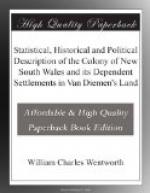The next tract of unappropriated country which I shall describe, is the district of the Coal River. The town of Newcastle is situated at the mouth of this river, and is about sixty miles to the northward of Port Jackson. Its population by the last census forwarded to this country, was five hundred and fifty souls. These, with the exception of a few free settlers, established on the upper banks of this river, amounting with their families perhaps to thirty souls, and about fifty troops, are all incorrigible offenders, who have been convicted either before a bench of magistrates, or the Court of Criminal Judicature, and afterwards re-transported to this place, where they are worked in chains from sunrise to sunset, and profitably employed in burning lime and procuring coals and timber, as well for carrying on the public works at Port Jackson, as for the private purposes of individuals, who pay the government stipulated prices for these different articles. This settlement was, in fact, established with the two-fold view of supplying the public works with these necessary articles, and providing a separate place of punishment for all who might be convicted of crimes in the colonial courts.
The coal mines here are considerably elevated above the level of the sea, and are of the richest description. The veins are visible on the abrupt face of the cliff, which borders the harbour, and are worked by adits or openings, which serve both to carry off the water and to wheel away the coals. The quantity procured in this easy manner is very great, and might be increased to any extent. So much more coals indeed are thus obtained than are required for the purposes of the government, that they are glad to dispose of them to all persons who are willing to purchase, requiring in return a duty of two shillings and six pence per ton, for such as are intended for home consumption, and five shillings for such as are for exportation.
The lime procured at this settlement is made from oyster shells, which are found in prodigious abundance. These shells lie close to the banks of the river, in beds of amazing size and depth. How they came there has long been a matter of surprise and speculation to the colonists. Some are of opinion that they have been gradually deposited by the natives in those periodical feasts of shell fish, for the celebration of which they still assemble at stated seasons in large bodies: others have contended, and I think with more probability, that they were originally large natural beds of oysters, and that the river has on some occasion or other, either changed its course or contracted its limits, and thus deserted them.
These beds are generally five or six feet above high-water mark. The process of making lime from them is extremely simple and expeditious. They are first dug up and sifted, and then piled over large heaps of dry wood, which are set fire to, and speedily convert the superincumbent mass into excellent lime. When thus made it is shipped for Sydney, and sold at one shilling per bushel.




